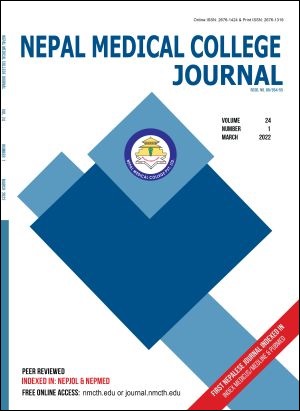Prevalence of Extended Spectrum Beta Lactamase producing Escherichia coli and Klebsiella spp. from urinary specimen in a tertiary care hospital
DOI:
https://doi.org/10.3126/nmcj.v24i1.44145Keywords:
Prevalence, ESBL, E. coli, Klebsiella, TEM, CTXM, urineAbstract
Escherichia coli and Klebsiella spp. are two important uropathogens showing resistance to beta-lactams by producing extended spectrum beta lactamase (ESBL), leading to difficulty in treating infections with these bacteria. Majority of the ESBLs are of TEM, CTXM and SHV types reported from Nepal. This study was conducted in Clinical Microbiology Department of Nepal Medical College Teaching Hospital from November 2021 to mid-January 2022 to determine prevalence of ESBL and antimicrobial susceptibility pattern among two common uropathogens. A total of 402 E. coli and Klebsiella spp. isolated from urine samples were included in the study. ESBL producing strains were identified by combination disc method and antibiotic susceptibility testing was done by Kirby Bauer’s disc diffusion method. PCR was done to detect the TEM and CTXM genes. Prevalence of ESBL among E. coli and Klebsiella spp. was found to be 14.9% (60/402). Among the E. coli, 16.1% (58/360) and only 4.8% (2/42) of Klebsiella spp. were ESBL producers. Antibiogram showed, 56.7% ESBL producers were susceptible to ciprofloxacin, 46.7% to co-trimoxazole, 96.7% to nitrofurantoin. However, all isolates were susceptible to amikacin, piperacillin-tazobactam, and carbapenems (both meropenem and imipenem). Among total 30 ESBL isolates selected by systematic random sampling, 3 isolates (all three E. coli) showed presence of TEM and 3 other isolates (two E. coli and one Klebsiella spp.) showed CTXM genes.
Downloads
Downloads
Published
How to Cite
Issue
Section
License
Copyright (c) 2022 Nepal Medical College Journal

This work is licensed under a Creative Commons Attribution 4.0 International License.
This license enables reusers to distribute, remix, adapt, and build upon the material in any medium or format, so long as attribution is given to the creator. The license allows for commercial use.




